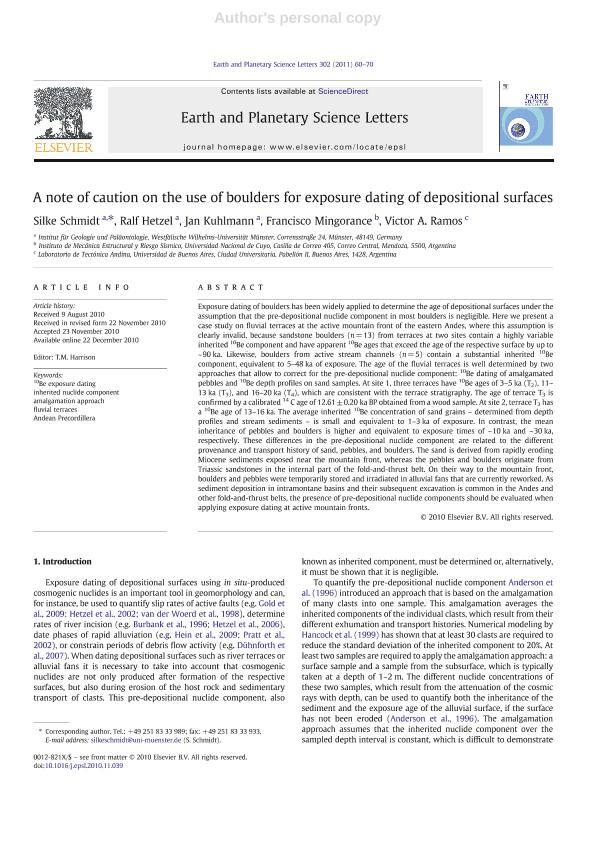Mostrar el registro sencillo del ítem
dc.contributor.author
Schmidt, Silke
dc.contributor.author
Hetzel, Ralf
dc.contributor.author
Kuhlmann, Jan
dc.contributor.author
Mingorance, Francisco
dc.contributor.author
Ramos, Victor Alberto

dc.date.available
2019-09-30T20:18:36Z
dc.date.issued
2011-02
dc.identifier.citation
Schmidt, Silke; Hetzel, Ralf; Kuhlmann, Jan; Mingorance, Francisco; Ramos, Victor Alberto; A note of caution on the use of boulders for exposure dating of depositional surfaces; Elsevier Science; Earth and Planetary Science Letters; 302; 1-2; 2-2011; 60-70
dc.identifier.issn
0012-821X
dc.identifier.uri
http://hdl.handle.net/11336/84855
dc.description.abstract
Exposure dating of boulders has been widely applied to determine the age of depositional surfaces under the assumption that the pre-depositional nuclide component in most boulders is negligible. Here we present a case study on fluvial terraces at the active mountain front of the eastern Andes, where this assumption is clearly invalid, because sandstone boulders (n=13) from terraces at two sites contain a highly variable inherited 10Be component and have apparent 10Be ages that exceed the age of the respective surface by up to ~90ka. Likewise, boulders from active stream channels (n=5) contain a substantial inherited 10Be component, equivalent to 5-48ka of exposure. The age of the fluvial terraces is well determined by two approaches that allow to correct for the pre-depositional nuclide component: 10Be dating of amalgamated pebbles and 10Be depth profiles on sand samples. At site 1, three terraces have 10Be ages of 3-5ka (T2), 11-13ka (T3), and 16-20ka (T4), which are consistent with the terrace stratigraphy. The age of terrace T3 is confirmed by a calibrated 14C age of 12.61±0.20ka BP obtained from a wood sample. At site 2, terrace T3 has a 10Be age of 13-16ka. The average inherited 10Be concentration of sand grains - determined from depth profiles and stream sediments - is small and equivalent to 1-3ka of exposure. In contrast, the mean inheritance of pebbles and boulders is higher and equivalent to exposure times of ~10ka and ~30ka, respectively. These differences in the pre-depositional nuclide component are related to the different provenance and transport history of sand, pebbles, and boulders. The sand is derived from rapidly eroding Miocene sediments exposed near the mountain front, whereas the pebbles and boulders originate from Triassic sandstones in the internal part of the fold-and-thrust belt. On their way to the mountain front, boulders and pebbles were temporarily stored and irradiated in alluvial fans that are currently reworked. As sediment deposition in intramontane basins and their subsequent excavation is common in the Andes and other fold-and-thrust belts, the presence of pre-depositional nuclide components should be evaluated when applying exposure dating at active mountain fronts.
dc.format
application/pdf
dc.language.iso
eng
dc.publisher
Elsevier Science

dc.rights
info:eu-repo/semantics/openAccess
dc.rights.uri
https://creativecommons.org/licenses/by-nc-sa/2.5/ar/
dc.subject
10BE EXPOSURE DATING
dc.subject
AMALGAMATION APPROACH
dc.subject
ANDEAN PRECORDILLERA
dc.subject
FLUVIAL TERRACES
dc.subject
INHERITED NUCLIDE COMPONENT
dc.subject.classification
Otras Ciencias de la Tierra y relacionadas con el Medio Ambiente

dc.subject.classification
Ciencias de la Tierra y relacionadas con el Medio Ambiente

dc.subject.classification
CIENCIAS NATURALES Y EXACTAS

dc.title
A note of caution on the use of boulders for exposure dating of depositional surfaces
dc.type
info:eu-repo/semantics/article
dc.type
info:ar-repo/semantics/artículo
dc.type
info:eu-repo/semantics/publishedVersion
dc.date.updated
2019-09-27T15:02:27Z
dc.journal.volume
302
dc.journal.number
1-2
dc.journal.pagination
60-70
dc.journal.pais
Países Bajos

dc.journal.ciudad
Amsterdam
dc.description.fil
Fil: Schmidt, Silke. Westfalische Wilhelms Universitat; Alemania
dc.description.fil
Fil: Hetzel, Ralf. Westfalische Wilhelms Universitat; Alemania
dc.description.fil
Fil: Kuhlmann, Jan. Westfalische Wilhelms Universitat; Alemania
dc.description.fil
Fil: Mingorance, Francisco. Universidad Nacional de Cuyo; Argentina
dc.description.fil
Fil: Ramos, Victor Alberto. Consejo Nacional de Investigaciones Científicas y Técnicas. Oficina de Coordinación Administrativa Ciudad Universitaria. Instituto de Estudios Andinos "Don Pablo Groeber". Universidad de Buenos Aires. Facultad de Ciencias Exactas y Naturales. Instituto de Estudios Andinos "Don Pablo Groeber"; Argentina
dc.journal.title
Earth and Planetary Science Letters

dc.relation.alternativeid
info:eu-repo/semantics/altIdentifier/url/https://www.sciencedirect.com/science/article/pii/S0012821X10007466
dc.relation.alternativeid
info:eu-repo/semantics/altIdentifier/doi/http://dx.doi.org/10.1016/j.epsl.2010.11.039
Archivos asociados
